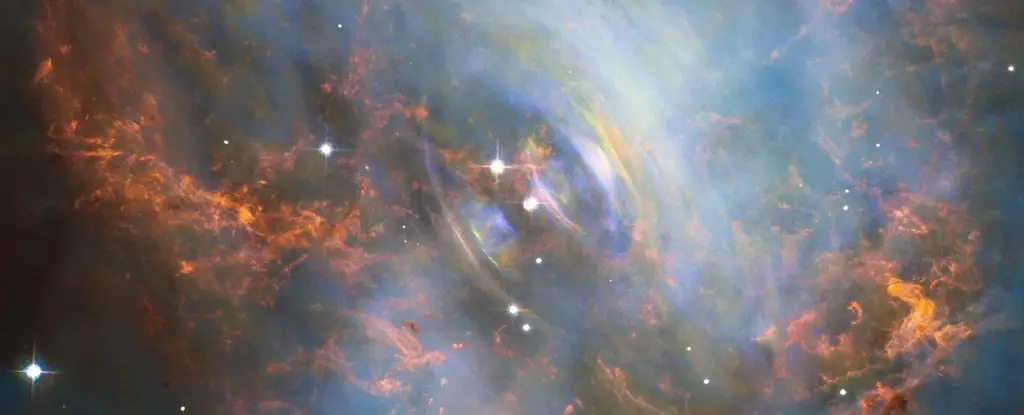Deep within the vast cosmos, the Crab Pulsar stands out as an extraordinary celestial object. Located approximately 6,200 light-years away, it is the remnant of a supernova explosion that occurred in 1054 CE, visibly blazing across the sky. This pulsar, a highly dense neutron star, emits powerful beams of radio waves that sweep past Earth, creating an effect akin to a cosmic lighthouse. While the various aspects of pulsars have been studied extensively, one phenomenon known as the “zebra pattern” has captured the curiosity of astronomers for nearly two decades. This article delves into the peculiarities of the Crab Pulsar and the groundbreaking theories proposed to elucidate the redundancy of its zebra pattern.
First observed in 2007, the zebra pattern is characterized by its unusual spacing of wavelength bands that, when graphed, resemble the stripes of a zebra. It is a unique emission signature that distinguishes the Crab Pulsar from other astronomical objects. Mikhail Medvedev, a theoretical astrophysicist at the University of Kansas, has stepped forward with a scientifically grounded hypothesis aimed at cracking this cosmic enigma.
Medvedev suggests that the zebra pattern is not merely an oddity; rather, it is an interference pattern produced by the diffraction of radio waves through varying plasma densities within the pulsar’s magnetosphere. This concept hinges on an understanding of wave optics—a branch of physics that addresses the behavior of light and other electromagnetic waves.
To comprehend Medvedev’s hypothesis, it becomes essential to grasp the basics of wave optics. Unlike geometrical optics, where light travels directly and casts shadows, wave optics recognizes that waves can bend around obstacles and interfere with themselves. This interference generates a series of light and dark fringes resulting from constructive and destructive patterns.
Medvedev articulates a scenario where radio waves emanating from the pulsar interact with a medium of charged particles, creating a distinctive diffraction pattern. Specifically, the neutron star’s powerful magnetic field generates a dense plasma, the density of which varies with distance. To visualize this, one can imagine that as radio waves traverse this plasma landscape, they pass through areas of varying density, resulting in interference that manifests in the zebra-like pattern.
Neutron stars are incredibly dense remnants of supernova explosions, compacting mass equivalent to about 2.3 times that of the Sun into a sphere of approximately 20 kilometers in diameter. These celestial objects are integral in producing pulsations; as the star rotates rapidly—approximately every 33 milliseconds—its radio emissions create a rhythmic pulsing effect.
The Crab Pulsar distinguishes itself from its counterparts in both the riches of observation data and its unique emissions. Medvedev’s model aligns closely with the statistical evidence gathered over decades of research on the Crab Pulsar, confirming that the zebra pattern aligns with the predicted interference pattern from this dense plasma.
Medvedev’s model is far more than an academic curiosity; it opens up new avenues for research in astrophysics. By applying his findings on the zebra pattern, researchers can gain deeper insights into the density of plasma within the magnetospheres of pulsars and potentially other extreme environments in space.
Such advancements hold promise for future astronomical discoveries. While the Crab Pulsar is remarkable in its characteristics, other young pulsars—of which there are hundreds—may also exhibit similar features, offering a treasure trove of data for continued exploration. Medvedev’s research underscores the ongoing mystery in our universe, revealing that even the most studied pulsars can still harbor secrets waiting to be unraveled.
Pursuing the intricacies of cosmic phenomena like the Crab Pulsar teaches us that the universe still holds unmatched wonders. With each new discovery, scientists like Mikhail Medvedev contribute to an evolving tapestry of knowledge about the cosmos. The zebra pattern remains a fascinating riddle, one that binds theoretical physics and observable astronomy. As researchers continue to harness the power of advanced models and data, they illuminate the shadows of the unknown, revealing the boundless complexities of our celestial neighborhood. As we continue to study pulsars and their peculiarities, each breakthrough not only quenches our thirst for knowledge but also beckons us to delve deeper into the enigmatic fabric of the universe.


Leave a Reply